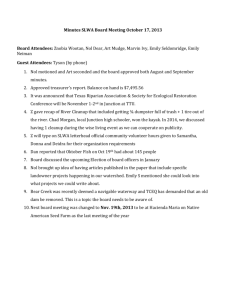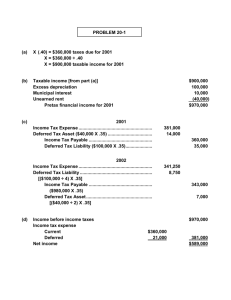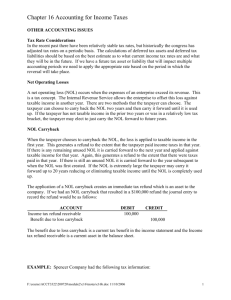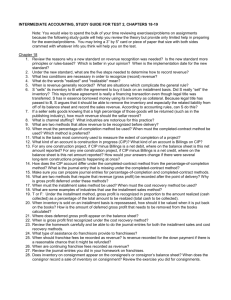Lesson 16
advertisement
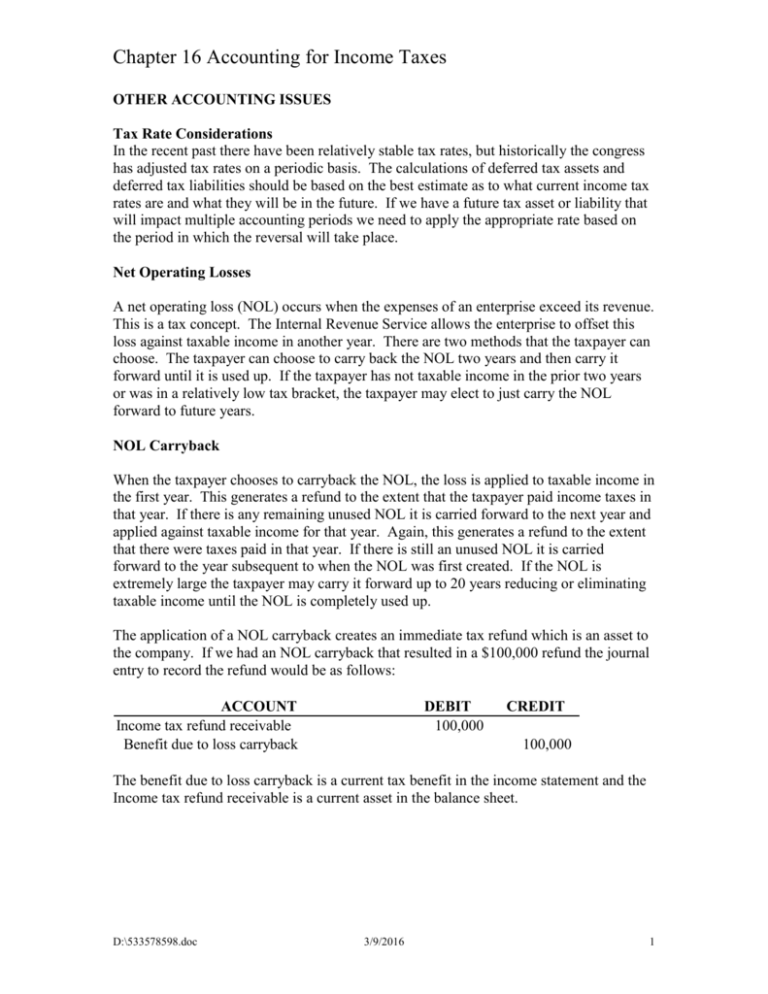
Chapter 16 Accounting for Income Taxes OTHER ACCOUNTING ISSUES Tax Rate Considerations In the recent past there have been relatively stable tax rates, but historically the congress has adjusted tax rates on a periodic basis. The calculations of deferred tax assets and deferred tax liabilities should be based on the best estimate as to what current income tax rates are and what they will be in the future. If we have a future tax asset or liability that will impact multiple accounting periods we need to apply the appropriate rate based on the period in which the reversal will take place. Net Operating Losses A net operating loss (NOL) occurs when the expenses of an enterprise exceed its revenue. This is a tax concept. The Internal Revenue Service allows the enterprise to offset this loss against taxable income in another year. There are two methods that the taxpayer can choose. The taxpayer can choose to carry back the NOL two years and then carry it forward until it is used up. If the taxpayer has not taxable income in the prior two years or was in a relatively low tax bracket, the taxpayer may elect to just carry the NOL forward to future years. NOL Carryback When the taxpayer chooses to carryback the NOL, the loss is applied to taxable income in the first year. This generates a refund to the extent that the taxpayer paid income taxes in that year. If there is any remaining unused NOL it is carried forward to the next year and applied against taxable income for that year. Again, this generates a refund to the extent that there were taxes paid in that year. If there is still an unused NOL it is carried forward to the year subsequent to when the NOL was first created. If the NOL is extremely large the taxpayer may carry it forward up to 20 years reducing or eliminating taxable income until the NOL is completely used up. The application of a NOL carryback creates an immediate tax refund which is an asset to the company. If we had an NOL carryback that resulted in a $100,000 refund the journal entry to record the refund would be as follows: ACCOUNT Income tax refund receivable Benefit due to loss carryback DEBIT 100,000 CREDIT 100,000 The benefit due to loss carryback is a current tax benefit in the income statement and the Income tax refund receivable is a current asset in the balance sheet. D:\533578598.doc 3/9/2016 1 Chapter 16 Accounting for Income Taxes EXAMPLE: Spencer Company had the following tax information: YEAR 1999 2000 2001 TAXABLE INCOME 300,000 325,000 400,000 TAX RATE 35% 30% 30% TAXES PAID 105,000 97,500 120,000 In 2002 Spencer Company suffered a net operating loss of $450,000, which it elected to carry back. The 2002 enacted tax rate is 29%. Using the format provided calculate the Income Tax Refund Receivable. Transaction 2002 NOL Carryback NOL Year Taxable Income Tax Rate Tax Paid Refund 2002 NOL Carryforward 2002 NOL Carryforward Income tax refund Solution: Transaction 2002 NOL Carryback 2002 NOL Carryforward 2002 NOL Carryforward Income tax refund NOL Year Taxable Income Tax Rate Tax Paid Refund (450,000) 2002 2000 325,000 30% 97,500 325,000 (325,000) (125,000) 0 30% 0 97,500 2001 400,000 30% 120,000 125,000 (125,000) 0 275,000 30% 82,500 37,500 135,000 Using the format provided prepare the journal entry to record the Income Tax Receivable as a result of the 2002 NOL carryback. ACCOUNT Income tax refund receivable Benefit due to loss carryback D:\533578598.doc DEBIT 3/9/2016 CREDIT 2 Chapter 16 Accounting for Income Taxes Solution: ACCOUNT Income tax refund receivable Benefit due to loss carryback DEBIT 135,000 CREDIT 135,000 NOL Carryforward If the taxpayer has no or relatively small taxable income in the previous two years it may be wise to elect to forgo the carryback and just carry the NOL forward. There are provisions in the IRS code to allow this election. EXAMPLE: Spencer Company had a NOL in 2002 of $500,000. The income tax rate has remained constant at 35% for the past few year and expected to remain the same in the near future. The company had taxable income in prior years as follows: YEAR 1999 2000 2001 TAXABLE INCOME 100,000 125,000 200,000 TAX RATE 35% 35% 35% TAXES PAID 35,000 43,750 70,000 Using the format provided calculate the Income Tax Receivable as a result of the 2002 NOL carryback. Transaction 2002 NOL Carryback NOL Year Taxable Income Tax Rate Tax Paid Refund 2002 NOL Carryforward 2002 NOL Carryforward Income tax refund D:\533578598.doc 3/9/2016 3 Chapter 16 Accounting for Income Taxes Solution: Transaction 2002 NOL Carryback 2002 NOL Carryforward 2002 NOL Carryforward Income tax refund NOL Year Taxable Income Tax Rate Tax Paid Refund (500,000) 2002 2000 125,000 35% 43,750 125,000 (125,000) (375,000) 0 35% 0 43,750 2001 200,000 35% 70,000 200,000 (200,000) (175,000) 0 35% 0 70,000 113,750 Please note that we still have not used up $175,000 of the 2002 NOL so we now have an NOL carryforward to 2003. This carryforward created a deferred tax asset to the extent that the company will be able to use this to off-set future income. As long as it is more likely than not that the company will continue to be profitable we can book a deferred tax asset. The calculation of the deferred tax asset would be as follows. Analysis of NOL Carryforward Unused NOL carryforward Enacted future tax rate Deferred tax asset 175,000 35% 61,250 Now that we know what the income tax refund and the deferred tax asset are we are ready to prepare the adjusting journal entry as of December 31, 2002 (the year the NOL was incurred.) Using the format provided prepare the December 31, 2002 adjusting journal entry to record the income tax refund and the deferred tax asset. ACCOUNT Income tax refund receivable Deferred tax asset Benefit due to loss carryback Benefit due to loss carryforward DEBIT CREDIT Solution: ACCOUNT Income tax refund receivable Deferred tax asset Benefit due to loss carryback Benefit due to loss carryforward D:\533578598.doc DEBIT 113,750 61,250 CREDIT 113,750 61,250 3/9/2016 4 Chapter 16 Accounting for Income Taxes Valuation Allowance-NOL Carryforward As discussed above the recording of a deferred tax asset as a result of a NOL carryforward is based on the expectation that the company will experience profitable operations in the future. If it is more likely than not that the company will not be able to take advantage of the NOL carryforward, a valuation allowance account must be established to reduce the carrying value. The carrying value of the deferred tax asset should be reflected in the balance sheet at the anticipated future benefit that will be utilized. Exercise: If in the previous exercise it was more likely than not that Spencer Company would never be able to utilize the NOL carryforward we would need to establish a valuation allowance account to reflect this expectation. The Valuation Allowance account entry would be record in the following manner. ACCOUNT Benefit due to loss carryforward Allowance to reduce deferred tax asset to expected realizable value DEBIT 61,250 CREDIT 61,250 At the end of the next year let’s assume that Spencer Company earned $300,000 in taxable income and that there are no permanent or temporary differences between taxable income and financial statement income. The calculation of the income tax expense and liability would be as follows. Taxable income Income tax rate Income tax expense 300,000 35% 105,000 It appears now that we will be able to use the deferred tax asset created by the NOL carryforward so the federal income tax liability for the year will be calculated as follows. Taxable income NOL carryforward Income subject to tax Income tax rate Income tax liability 300,000 (175,000) 125,000 35% 43,750 There are now two adjusting journal entries. The first entry will record the current and deferred income taxes and the second entry will eliminate the allowance account. D:\533578598.doc 3/9/2016 5 Chapter 16 Accounting for Income Taxes ACCOUNT Income tax expense Deferred tax asset Income tax payable DEBIT 105,000 ACCOUNT Allowance to reduce deferred tax asset to expected realizable value Benefit due to loss carryforward DEBIT CREDIT 61,250 43,750 CREDIT 61,250 61,250 Financial Statement Presentation Balance Sheet: Deferred taxes are reported on the balance sheet as either deferred tax assets or deferred tax liabilities. The nature of classification of the account as current or not current is determined based on the underlying asset or liability. If the underlying asset or liability is current then the deferred tax asset or liability is classified as current. In most cases there will be a number of deferred tax accounts reflecting the various timing differences between book and tax income. For financial reporting purposes all of the current deferred tax assets and deferred tax liabilities should be combined into a single amount and reported at the net current deferred tax asset or liability. Likewise, all of the noncurrent amounts should be combined into a single account for financial statement presentation purposes. It the event that there is no underlying asset or liability related to a deferred tax asset or liability, the account should be classified as current or noncurrent based on the expected date that the temporary difference will reverse. For example, an NOL carryforward does not have an underlying asset. This deferred tax asset would be classified as current if it was expected to reverse in the next operating cycle. Income Statement: Most of the material we have presented deals with income tax expense or benefit related to income from continuing operations. An intraperiod tax allocation must be made between continuing operations, discontinued operations, extraordinary items, the cumulative effect of a change in accounting principle and prior period adjustments. In addition, current tax expense or benefit and deferred tax expense or benefit from continuing operations must be presented in the income statement. D:\533578598.doc 3/9/2016 6
